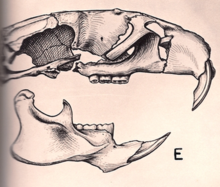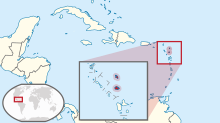| "Ekbletomys" | |
|---|---|

| |
| Side view of the holotype skull | |
| Scientific classification (unresolved) | |
| Domain: | Eukaryota |
| Kingdom: | Animalia |
| Phylum: | Chordata |
| Class: | Mammalia |
| Order: | Rodentia |
| Family: | Cricetidae |
| Subfamily: | Sigmodontinae |
| Tribe: | Oryzomyini |
| Genus: | †"Ekbletomys" Ray, 1962 (unavailable name)
|
| Species: | †"E. nasuta"
|
| Binomial name | |
| †"Ekbletomys nasuta (Ray, 1962) (unavailable name)
| |

| |
| Location of Antigua and Barbuda, where "Ekbletomys hypenemus" was endemic | |
"Ekbletomys hypenemus" is an extinct[1] oryzomyine rodent from the islands of Antigua and Barbuda, Lesser Antilles. It was described as the only species of the subgenus "Ekbletomys" of genus Oryzomys in a 1962 Ph.D. thesis, but that name is not available under the International Code of Zoological Nomenclature and the species remains formally unnamed. It is currently referred to as "Ekbletomys hypenemus" in the absence of a formally available name.[2] The species is now thought to be extinct, but association with introduced Rattus indicates that it survived until before[clarification needed] 1500 BCE on Antigua.[citation needed]
It is known from abundant skeletal elements, which document it as the largest known oryzomyine, on par with Megalomys desmarestii, another Antillean endemic. Its morphological features indicate that it is distinct from Megalomys, which includes various other Antillean oryzomyines, and derives from a separate colonization of the Lesser Antilles by oryzomyines. In the original description, it was placed close to a species now placed in Nephelomys, but its relationships have not been studied since.